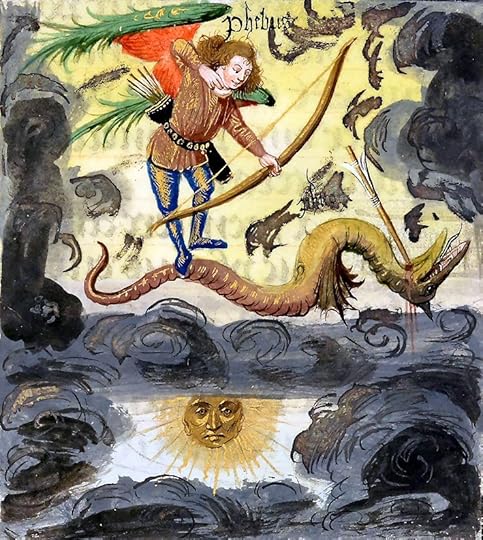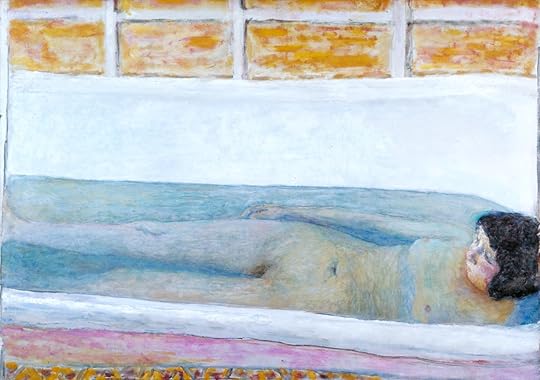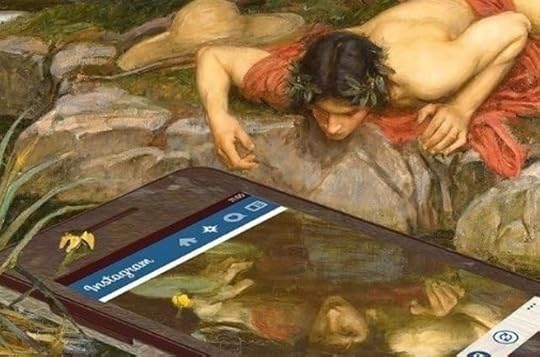 Roger’s
Comments
(group member since Aug 29, 2018)
Roger’s
Comments
(group member since Aug 29, 2018)
Roger’s
comments
from the Ovid's Metamorphoses and Further Metamorphoses group.
Showing 241-260 of 419
 One more Apollo picture to post: a manuscript illuimination of him slaying Python:
One more Apollo picture to post: a manuscript illuimination of him slaying Python:
Bruges, 1470–88. Apollo and Python.
I love the well-dressed young-man-about-town quality of the god. I love the very free drawing style and the color. And I am intrigued by the inversion of the expected design, with the sun—a very quizzical sun—in the bottom of the picture rather than at the top! R.
 Kalliope wrote: "When it became more clear to me that Actaeon, Pentheus and Bacchus are first cousins (their respective mothers - Autonoë, Agave and Semele - are sisters), and that they are the grandchildren to whi..."
Kalliope wrote: "When it became more clear to me that Actaeon, Pentheus and Bacchus are first cousins (their respective mothers - Autonoë, Agave and Semele - are sisters), and that they are the grandchildren to whi..."So it is striking that the final story in the book, that of Pentheus, ends with the dissolution of normal family bonds. After refusing to acknowledge the godhood of his cousin Bacchus, he is torn apart by his own mother and sisters!
That said, I find your two recent comments extremely helpful. R.
 Ce Ce, thank you so much for this appreciation! Your many readings: are they all in the same version, or do you try different ones? I have fun juggling four of them at the moment, plus various spin-offs. R.
Ce Ce, thank you so much for this appreciation! Your many readings: are they all in the same version, or do you try different ones? I have fun juggling four of them at the moment, plus various spin-offs. R.
 Ce Ce wrote: "Weren't the nymphs wearing shifts…?"
Ce Ce wrote: "Weren't the nymphs wearing shifts…?"You may be right. I thought not, as the physical features seemed to move with the bodies rather than with the flow of the fabric. But they are suspiciously uniform. And I can see that a costume that is in fact opaque would put the singers more at ease. But from the point of view of the audience… well…!
I also note that both the director and the cameraman give the scene a distinctly Sapphic eroticism, in the way the nymphs appear to fondle one another. No doubt there is a similar sensuality in Charpentier's music, and it would certainly make Actaeon's transgression that much worse. But is this really implied in Ovid? R.
 Jim wrote: "Adopting CSL's notion of allowing the book to take you on an awareness journey, leaving your prejudices behind might result in an entirely different set of conclusions..."
Jim wrote: "Adopting CSL's notion of allowing the book to take you on an awareness journey, leaving your prejudices behind might result in an entirely different set of conclusions..."To put what I think I've said before in a slightly different way, we have at least three sets of prejudices to deal with here, don't we? Or maybe I should say moral windows.
1. One is of course our literal prejudices, the biases we come with, which we do indeed need to leave behind.
2. At the other end, is what Ovid is actually saying. But just as most of us don't read Latin fluently, we need to translate that, to understand his thought against the framework of his time. We can't read him entirely innocently, as if the political and belief system within which he was writing had no meaning.
3. And then there are all those prejudices in the middle. As many of us are looking at what later artists and writers have made of Ovid, we have the changing expectations of intervening centuries to take account of also.
As for me, I believe I can handle #1, if I think about it enough. Not being a classical historian, I do have trouble with #2. And I'm sure I'm subject to corruption by #3. In many cases, I know the Ovid stories first through the intermediary of the art, music or literature from the 15th century onwards, and I tend to think that the attitudes of these more modern periods are built-in to Ovid's writing itself. Not true, of course, but it can take a considerable effort to remember that. R.
 Echo essentially disappears into the woods; Cusk's protagonist, on the other hand, comes more or less into focus. R.
Echo essentially disappears into the woods; Cusk's protagonist, on the other hand, comes more or less into focus. R.
 Roman Clodia wrote: "I don't know that book by CSL but have to admit I'm somewhat puzzled by his classif..."
Roman Clodia wrote: "I don't know that book by CSL but have to admit I'm somewhat puzzled by his classif..."It has been a long time, RC, and I rather imagine I would pick holes in it myself were I to read it now. My biggest takeaway remains, though: that art, to be great, must bring something to us that wasn't there before.
You are not alone; I don't get the Mona Lisa either. It is a fine painting, certainly, by a unique and highly accomplished artist, but its enshrinement at the Louvre and in the public imagination has more to do with reputation than fact. We celebrate the myth even more than the object.
Part of greatness, I should think, is the ability to continue to deliver. You often hear people saying that they don't like Rubens: all that flesh, those plump angels, that cloying color. I used to think the same. But as I kept coming back to him, I kept finding narrative solutions to his stories that were both insightful and right, and formal solutions to religious subjects that showed the work of a great director and designer in one. There are few artists who can sustain in this way; Titian, as we have seen in his Callisto, Actaeon, and Europa, is another.
I have not yet made my mind up about Ovid. I like his surfaces (unlike my first impression of Rubens); I have been entertained by many of his stories; I am in awe of his scope. But we are still only on Book III. As we go on, will the later stories just be repetitions of old tropes with new names, or will he continue to amaze? We shall have to see. R.
 The Wikipedia article also, as I remember, lists the stories within each book. Minor characters, from Diana's attendants to Actaeon's hounds, are of course a different matter. But do we need to remember them all? R.
The Wikipedia article also, as I remember, lists the stories within each book. Minor characters, from Diana's attendants to Actaeon's hounds, are of course a different matter. But do we need to remember them all? R.
 Kalliope wrote (post #25): "Jacob Jordaens. 1636-38. Prado..."
Kalliope wrote (post #25): "Jacob Jordaens. 1636-38. Prado..."Looking at this again. You wouldn't normally expect Jordaens to improve on Rubens. But look at the top: what a difference the extra space between Cadmus and Minerva makes, the filling out of the tree behind her, the fact that he is looking at her and not down, and the generally cooler color chord than you typically find in a Rubens. R.
 Thanks for the compliment, RC!
Thanks for the compliment, RC!The book by CSL that I was referring to is probably his least well-known, and possibly quite deprecated, An Experiment in Criticism. His whole idea was to get away from thinking about good and bad art (whether on supposedly pure aesthetic criteria, historical context, or anything else), and think instead of good and bad reactions to it. If one's only response on seeing a picture is to be reminded of the tablecloth Great Aunt Edna had on her tea table, then what would be the point of going to the gallery in the first place? Art is only bad, by this criterion, if it leaves a majority of its consumers with little more than they brought to it in the first place.
In other words, so far from thinking in terms of rigid and perhaps outmoded criteria, this shows CSL willing at least in theory to accept an aesthetic universe with no fixed criteria at all.
[Apologies if I was a bit scattered yesterday. I was spending my 78th birthday sitting in a hospital ER room with my son, but all is now well.] Roger.
 Both your last two postings are very interesting, Kalliope. I like the Gleyre very much. Again, it is an example of how certain antique subjects persist, even when the more adventurous sides of the art world are doing quite different scenes. I noted in my own Pentheus postings that most of the more modern ones seem to hark back to much older styles. As does the male figure in the Gleyre. But those silhouettes of the Maenads seem to come from Hugo or Poe.
Both your last two postings are very interesting, Kalliope. I like the Gleyre very much. Again, it is an example of how certain antique subjects persist, even when the more adventurous sides of the art world are doing quite different scenes. I noted in my own Pentheus postings that most of the more modern ones seem to hark back to much older styles. As does the male figure in the Gleyre. But those silhouettes of the Maenads seem to come from Hugo or Poe.Without the title and perhaps the costuming, the van Baburen could easily be a genre painting; just a man stopping by a basin of water. Striking though it is, it says little narratively; we need to know more. And—nitpicking here—water coming so strongly out of a spout into a small basin would not leave so smooth a reflective surface.
As to the two earlier pictures of the Presentation of Narcissus, what strikes me is that, before you see all the details, you have the format of some Christian story, such as the Presentation of Christ. Not the first time I have questioned the apparent interchangeability of sacred and pagan motifs. R.
 Roman Clodia wrote: "Roger wrote:."... is, according to CSL, second-rate."
Roman Clodia wrote: "Roger wrote:."... is, according to CSL, second-rate."Possibly off-topic, but is it helpful, do we think, to apply value judgements like 'second rate' and 'first rate' to artworks (including texts..."
Fair question. CSL was one of my professors, in his Cambridge incarnation, and a great man to talk to, but he was already regarded as passé even then.
But yes, I think we need criteria. Artists, after all, aim for an ideal, or excellence in their craft at the very least. But having criteria is not inconsistent with the willingness to reevaluate them. I can't talk more at the moment, but I am certainly willing to continue this, perhaps via direct message. R.
 Roman Clodia wrote: "Oh, undoubtedly titillation!..."
Roman Clodia wrote: "Oh, undoubtedly titillation!..."Of course I agree. But it is also a question of degree. I guess I'm going back to the CS Lewis distinction between what we bring to a work of art and what it brings to us. The latter is what is important. A work whose main function is to trigger our preexisting memories or obsessions to run a course outside it is, according to CSL, second-rate.
On the whole, though, Kalliope and I have been avoiding such works. R.
 Kalliope wrote: "We, the viewers, could be the Actaeon."
Kalliope wrote: "We, the viewers, could be the Actaeon."Kalliope, I'd be 99% sure that Lichtenstein was thinking of popular magazine sources rather than mythological ones in his Woman in a Bath, but no matter. I have never fully understood the aesthetic of this strain of pop art. Are we meant to see it just as a stylistic transformation from low into high art? Or does he go farther in his choice of subjects, to say something enduring about the underlying situation?
This is triggering two separate thoughts in my mind; let's see if I can connect them.
1. What would Actaeon have to have done to make him in any way deserve Diana's punishment?The old definition of a gentleman is of one who, when walking accidentally in on a woman in the bathroom, says "Excuse me, sir," and walks out. If Actaeon saw Diana naked and immediately turned away, he would indeed be blameless by any normal standards. But if he lingered, that would be a different matter, wouldn't it? It is possible to rape, or at least assault someone, solely with one's eyes, by following the first neutral glance with the active use of the imagination.
2. In the Lichtenstein, the woman isn't revealing anything at all. She may be naked under the water, but that is left entirely to our imagination.

Bonnard: The Bath, 1925. London, Tate.
Compare the Lichtenstein to one of Bonnard's many paintings of his wife in the bath. There is no invitation to a prurient imagination there: she is as she is; there is nothing to imagine, only the light, paint, and color to enjoy. But the Lichtenstein—or rather the pulp illustration that was his source—is all about titillation. The hairstyle, the sponge, the bubbles, all have a frou-frou quality that say "Ooh, la, la!" Lichtenstein's enlargement of it merely points this out.
I am not sure where this gets us, except perhaps as a principle that we might apply to representations of Ovid's many erotic subjects. To what extent are they illustrating Ovid, and to what merely using him to titillate the viewer's imagination? R.
 THE SO-CALLED ACTAEON BALLET. Kalliope and Jim, let me refer you to the link below, not so much to watch the dance as to open the note below the screen (click the down arrow at bottom right). The writer explains with obvious knowledge why this should not be Diana and Actaeon at all, but had a quite different origin. R.
THE SO-CALLED ACTAEON BALLET. Kalliope and Jim, let me refer you to the link below, not so much to watch the dance as to open the note below the screen (click the down arrow at bottom right). The writer explains with obvious knowledge why this should not be Diana and Actaeon at all, but had a quite different origin. R.https://youtu.be/X-iPbSy9Ce0
 Elena wrote: "And female passion seems to be something Ovid knew a lot about....Echo, Salmacis, Medea, Clytie, Procris, Myrrha, Scylla, Venus herself and then the Bacchantes, yikes! ..."
Elena wrote: "And female passion seems to be something Ovid knew a lot about....Echo, Salmacis, Medea, Clytie, Procris, Myrrha, Scylla, Venus herself and then the Bacchantes, yikes! ..."Yes, but am I alone in thinking that this is something he doesn't entirely approve of, an ungoverned animality that comes about when women do not conform to male-ordained expectations? R.
 TED HUGHES. I originally posted this as part of my regular Goodreads review of Ted Hughes' Tales from Ovid, but I think it may be worth reposting here.
TED HUGHES. I originally posted this as part of my regular Goodreads review of Ted Hughes' Tales from Ovid, but I think it may be worth reposting here.
Poussin: The Triumph of Bacchus, 1635. Kansas City, Nelson-Adkins Museum.
Some of Hughes' flights of fantasy are truly marvelous. Near the beginning of the story of Bacchus and Pentheus, there is a short passage—three lines of Latin, four in the Garth/Dryden translation—describing the frenzy when the young god comes to town:
For now through prostrate Greece young Bacchus rode,Hughes, however, expands Ovid's three lines to eighteen, a headlong tumble of invention that surely channels the Browning of The Pied Piper of Hamelin:
Whilst howling matrons celebrate the God:
All ranks and sexes to his Orgies ran,
To mingle in the pomps, and fill the train.
The god has come. The claustrophobic landscape"Physicians, morticians, musicians, magicians" — Hughes is worth reading for such language alone! R.
Bumps like a drum
With the stamping dance of the revellers.
The city pours
Its entire population into the frenzy.
Children and their teachers, labourers, bankers.
Mothers and grandmothers, merchants, agents,
Prostitutes, politicians, police,
Scavengers and accountants, lawyers and burglars,
Builders, laybouts, tradesmen, con-men,
Scoundrels, tax-collectors, academicians,
Physicians, morticians, musicians, magicians,
The idle rich and the laughing mob,
Stretched mouths in glazed faces,
All as if naked, anonymous, freed
Into the ecstasy,
The dementia and the delirium
Of the new god.
 Peter wrote: "I just finished reading the beautiful story of Echo and Narcissus ..."
Peter wrote: "I just finished reading the beautiful story of Echo and Narcissus ..."I am sure you are right, Peter. If you hunt for Narcissus illustrations, you will discover that many of them have been reposted on what are clearly gay sites.
You are also right about social media. Here is one picture I found on the web, a parody of the William Waterhouse classic, called Modern Narcissus. Point made, I think! R.

 Kalliope wrote: "By pure chance I found this 6 minute video on a Ballet piece on Diana & Actaeon..."
Kalliope wrote: "By pure chance I found this 6 minute video on a Ballet piece on Diana & Actaeon..."Kall, I originally posted this when we started the book, but then withdrew it, as I didn't think it relevant to Ovid. The piece, choreographed by Marius Petipa, has a complicated history, and was not even intended to represent Diana and Actaeon at all. It is essentially nothing but a virtuoso love duet, transferred from its original context to become an episode in a longer ballet, Esmeralda. There is no indication whatever of Actaeon spying on Diana or being punished by her.
Except that, in one version I found, someone has inserted brief poses for the two dancers after the pas-de-deux proper is over. Take a look at this ten-second clip. But don't blink; you might miss it! R.
https://youtu.be/XNaS3Ahz8wU?t=230

